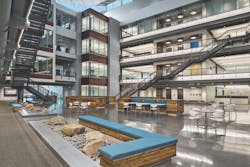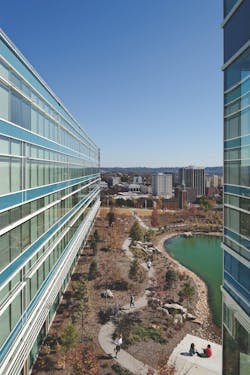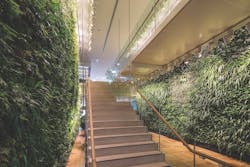Wellness by design
On July 25, Lendlease moved into its new global headquarters, Tower Three of the 277,200-sm International Towers Sydney in the Sydney, Australia, suburb of Barangaroo. These towers are in the process of becoming the first buildings certified under the International WELL Building Institute’s Core and Shell health and wellness standard. Tower Three is shooting for Platinum, IWBI’s highest certification level.
Moving into Tower Three was the culmination of a two-year wellness effort that began with Lendlease launching its Health & Well-being Framework in 2014 to support its employees’ physical and mental well-being.
The builder/developer partnered with Bupa, an international healthcare group, to gather relevant baseline data about Lendlease’s workforce from more than 114 work sites worldwide. In 2015, Lendlease conducted a comparative workplace survey to inform its wellness strategy, which now includes Bupa providing preventive services such as skin and health checks, flu vaccinations, and health coaching for the company’s Australian and European operations.
“Health and wellness have a direct impact on productivity through improved employee engagement and morale, better teamwork, enhanced social networks, and reduced absenteeism,” asserts Geoff Dutaillis, Lendlease’s Group Head of Sustainability.
Lendlease has identified several other buildings and tenancies in Europe, Australia, and the U.S. that it plans to submit for WELL certification. The firm is in the vanguard of a wellness movement that is striving to become the next big thing—following high performance and sustainability—for developers, building owners, employers, and their AEC partners to pursue. The three-year-old IWBI is attempting to position its performance-based standard and certification process to play a defining role in shaping that movement, just as USGBC’s LEED system did for the green building market.
“Certifying under WELL was a catalyst for a larger conversation about connecting human resources and real estate,” says Martha MacInnis, Design Director with TD Bank Group, whose 18-month-long optimization of 25,000 sf on the 23rd floor of the TD Centre in Toronto became the first project in the world to achieve certification under v.1 of the WELL Building Standard. That project was part of a 50-floor renovation in that building, which will allow TD Bank to compare occupant health data within different work environments.
“WELL fills a void that needed to be filled,” says Joan Blumenfeld, FAIA, FIIDA, LEED AP ID+C, Global Interior Design Director with Perkins+Will, based in the firm’s New York office. She is leading interior projects in San Francisco and Dallas for developer Haworth that are targeting LEED Gold and WELL certifications.
It’s no coincidence that WELL and LEED are often mentioned in the same sentence. Rick Fedrizzi, the former President and CEO of the U.S. Green Building Council, is now IWBI’s CEO. And the Green Building Certification Institute is the third-party certifier for both LEED and WELL. GBCI entered into a formal collaboration with IWBI in April to help streamline how the two standards work together.
“Greenness and wellness go hand in hand, and the systems are complementary,” says Paul Scialla, the former Goldman Sachs exec who is Co-founder and CEO of Delos, a Manhattan-based real estate firm that launched IWBI in 2013 and its WELL Building Standard in October 2014 (see sidebar, page 24).
Scialla believes the association with GBCI has been “extremely important in taking the WELL Building standard global.” Third-party certification could also be a market differentiator, as competing wellness standards and measurement tools are coming out.
An obstacle for any wellness standard or measurement is overcoming skepticism from ROI-obsessed developers and building owners. It’s a lot more complicated to quantify the cost benefits of wellness than, say, reducing energy consumption, especially when some of the supporting evidence connecting health, wellness, and productivity is based as much on impressions as it is on science.
“Employee happiness and wellness are, in part, perceptions,” says Megan Leslie, PE, LEED AP BD+C, Associate and Sustainability Consultant with Stantec and a WELL Accredited Professional.
The industry’s embrace of wellness as a design, construction, and operations goal could rest on convincing companies that healthier environments can help reduce their biggest line item expense—their workforce—and make their employees happier and less susceptible to illness in the process.
“The question, ‘Do healthier building practices mean healthier spaces?’ is still too abstract for most building owners,” Scialla acknowledges. “However, if the question is whether a WELL-certified space is a healthier space, that’s something we can start to put factual yeses to.”
Linking health and human performance
Scialla estimates that global spending on health and wellness products, services, and initiatives has “been growing at more than 20% per year, and accelerating.” His vision for Delos is to use real estate as the vehicle that delivers preventive wellness and healthier living to people around the world who spend 90% of their days and nights indoors.
Clearly, developers and property owners are looking beyond the performance of their buildings, with one eye on boosting productivity and controlling costs, the other on attracting and retaining employees.
The Integrated Benefits Institute estimates that health-related productivity losses cost U.S. employers over $225 billion annually. Conversely, a recent JLL research paper reported 20% productivity gains from workplaces that have been “greened.” Another paper, published in May 2015 in the Journal of Occupational and Environmental Medicine, contended that companies with strong health and wellness programs outperform others on the stock market. That paper proposed an Integrated Health and Safety Index, modeled after the Dow Jones Sustainability Index, to assess the “business value” of wellness measures.
“We’ve seen an increase in clients with an interest in wellness and WELL, which covers a range of topics outside of LEED’s framework,” says Mike Cavanaugh, AIA, LEED AP, Vice President and Sustainability Leader with CannonDesign. “Americans are working longer, and WELL goes a long way toward making sure the human health aspect is looked at as deeply as possible.”
Suzanne Drake, LEED AP ID+C, Senior Associate and Research Director with Perkins+Will, sees wellness as “a natural extension of sustainability.” Kena David, Sustainability Manager with BCCI Construction, observes that Millennial workers are “really pushing” their companies to jump onto the workplace wellness bandwagon.
In early August, BCCI’s 16,152-sf office in San Francisco was preparing to go through performance and documentation verification to certify under the WELL Building Standard. Among the changes BCCI made to meet the standard were adding ergonomic workstations, eliminating sodas and sugary snacks, and installing a water filtration system that dispenses hot, cold, and sparkling water on demand.
Tracking Early adopters of wellness programs
In Orlando, Fla., Tavistock Development always intended to master plan around health and wellness for Lake Nona, its 7,000-acre community with homes for 11,000 residents, school and university facilities, 10 million sf of retail, a 650-acre medical center, and a sports and innovation district that includes a USTA tennis complex with more than 100 courts.
“But there wasn’t a wellness ‘cookbook,’” recalls Gloria Caulfield, Tavistock’s Vice President of Strategic Alliances, and Executive Director of the Lake Nona Institute, a nonprofit that incubates and measures technologies and programs as global models for building healthy, sustainable communities.
Last year, Lake Nona entered into an agreement with Delos to bring multiple health and wellness programs to its community. The first project was Intelligent Home, a model home with wellness amenities such as advanced air and water filtration, that Lake Nona views as its “living lab,” says Caulfield. Lake Nona incorporated Delos’s WELL Signature program into Landon House, its 280-unit luxury apartment building. And Delos provided hospitality designs for 34 StayWell rooms with more than 20 health and wellness amenities in a Marriott hotel on Lake Nona’s campus.
Before Tavistock went down this road, the company asked itself how much of Delos’s holistic wellness approach it would have done anyway. The developer concluded there would be only 3-5% overlap. “Delos got into dozens of areas that we didn’t have the expertise to contemplate,” says Caulfield, particularly in the area of nutrition.
Lake Nona has committed to pursue WELL certification for several of its commercial office buildings. And it’s putting together a wellness package of amenities for homebuyers, as well as an interactive app.
Several years ago, when real estate giant CBRE was planning to move into a new corporate headquarters in Los Angeles, the firm explored an open-plan design that would eliminate private offices. However, openness led to concerns among its employees about hygiene and how they could control their own spaces.
Those concerns put Delos and its wellness program on CBRE’s radar, says David Pogue, the company’s Global Director of Corporate Responsibility. One thing led to another, and in 2013 CBRE became the first company to achieve certification for a commercial office through the WELL Building Standard’s pilot program.
Last February, Delos and CBRE expanded their strategic alliance. CBRE will pursue WELL certification for at least 100 buildings, sites, and offices it controls worldwide. In April, it became a founding alliance member of the Well Living Lab, a collaboration between Delos and the Mayo Clinic (see BD+C January 2016 issue, http://bit.ly/2b7WHpt). And CBRE plans to accredit 50 of its employees through the WELL Accredited Professional program.
Pogue and several other sources point out that what separates WELL from other certifications is that it’s achievable only if landlords buy into wellness as an operational necessity.
A prime example is TD Centre, which is majority-owned by developer Cadillac Fairview. David Hoffman, TD Centre’s GM, says that of the WELL Building Standard’s 102 features, 38 are fully dependent on the landlord, and another 28 must be supported by the landlord. These include a smoking ban in the building, its ventilation, mold control, water quality, thermal control, solar glare, and lighting.
“It would be virtually impossible for a tenant to achieve WELL certification without the landlord’s support,” says Hoffman.
Calculating wellness's return on investment
Landlord buy-in, however, is where wellness certification gets tricky.
Building to WELL’s standard typically adds 1-2% to the construction cost of a new building, according to AEC and developer sources. Renovating to the standard can be more expensive. “It’s possible to get WELL into a design without a premium,” says P+W’s Drake. “But the fee issue is a separate matter, because certification requires performance-based testing.”
Using IWBI’s pricing calculator to certify a 25,000-sf new or existing interior space (roughly what TD Bank renovated), a property owner would pay a $1,800 registration fee and $20,000 for document review, performance verification, and certification (which IWBI is currently discounting to $10,000). To certify a three million-sf building complex (roughly the size of International Towers Sydney) under WELL’s Core and Shell standard, the registration fee would be $6,500, and the document review, performance verification, and certification would cost $560,000 (minus 35% for the “early adopter” discount).
Whether owners and developers think WELL is worth the investment could hinge on how compelling they find the research that implies that employees are healthier and more productive in spaces designed with wellness in mind.
The wellness movement “stems from an interesting intersection of science, psychology, physiology, and architecture,” says Drake. “We want to control some of these effects, and make them more meaningful.”
That sometimes requires a leap of faith, because while there is promising evidence on productivity associated with health and wellness strategies, the research supporting such claims is sometimes hypothetical, incomplete, or based on limited data.
“It’s like ‘Jeopardy!’—What’s the question for which wellness is the answer?” quips Chris Pyke, COO of the Washington-based Global Real Estate Benchmark (GRESB), which assesses property, development, and funds for investors.
Pyke compares wellness research to standing at the edge of an ocean. “The big picture is that the built environment has an incredible impact on people’s health. But when you zoom in on things like air quality, it gets granular and harder to quantify.”
For instance, there’s been lots of research done showing how natural indoor light that maintains circadian rhythms can positively impact a person’s metabolism, but virtually no research proving that artificially induced daylighting works the same way.
Last year, a research paper linking worker cognition to indoor air quality caused some excitement in scientific and industry quarters. But that research, peer-reviewed by Harvard University’s T.H. Chan School of Public Health, involved only 24 healthy AEC and marketing employees whose physical conditions were hardly representative of the workforce in general.
Pogue concedes that WELL’s fees would be a tough sell if they were justified solely on cost per square foot. That’s especially true because some wellness metrics are difficult to attribute directly to compliance with a standard, adds Onno Zwaneveld, Executive Vice President with CBRE. But Pogue and Zwaneveld believe that companies are beginning to view wellness differently, in terms of cost per employee and whether health and wellness measures can make a significant contribution to lowering those costs.
Pogue points to CBRE’s 2014 Workplace360 study, which surveyed its employees after they moved into its L.A. headquarters. That poll found that 83% felt “more productive,” 92% thought the new space “created positive effects on their health and well-being,” and 94% thought the space “created a positive impact on [their] business performance.”
will More projects yield better research
CBRE is working with Harvard to field test the cognition/air quality research. As the wellness movement advances, it is spurring more extensive research:
• GRESB recently added health and wellness as a “critical development topic” to its business survey, as well as a voluntary module to learn what companies were doing. More than 150 companies have completed the module, and Pyke expects that number to rise to 800 by next summer. “The goal is to make wellness more visible to investors,” he says.
• Lake Nona and Johnson & Johnson have embarked on a program where 1,000 residents have agreed to share their health data for a research project to determine if the master-planned community can shape wellness and quality of life.
• The IWBI is partnering with the American Society of Designers in a pre- and post-occupancy study with Cornell University on the health impacts of ASID’s new 8,500-sf headquarters, designed by P+W. As part of this research, ASID staffers volunteered to wear monitors that measure speech patterns and body movement.
wellness field starting to get more crowded
The wellness movement is also spurring new ways to measure and execute wellness-centric building practices. In July, HDR unveiled its wellness dashboard tool that measures wellness design cost benefits.
Colin Rohlfing, AIA, LEED AP BD+C, Vice President and Director of Sustainable Development with HDR, says the tool is a response to some of the “fuzzy science” that he says is still relied on to implement wellness strategies, which inevitably “get value engineered out of the design.”
HDR’s computational group developed a model for human interaction with health and wellness components that includes a “discrete event simulator” to gauge a person’s contact with, say, daylighting or biophilic elements. The firm’s research team vetted reams of research to plug into the tool. The team drew from 50 papers on daylighting alone.
Last May, the nonprofit Center for Active Design (CAD) launched Fitwel, a new building certification program that had been five years in the making by the Centers for Disease Control and Prevention. CDC piloted the program with 89 buildings owned by the General Services Administration and New York City.
Fitwel is being positioned as a lower-cost, business-friendlier alternative to the WELL Building Standard. The program—which CAD, its third-party certifier, is licensed to manage—revolves around seven categories and 60-plus health and wellness benchmarks. Fitwel’s online tool and certification process “let a company figure out where it is [in terms of wellness],” and then work toward a strategy for improvement, says Joanna Frank, Executive Director of the Center for Active Design. Each strategy would have its own point calculations.
CAD is recruiting Fitwel “champions” that are willing to apply its benchmarks to their own real estate. This fall, CAD plans to roll out Fitwel to AEC firms that agree to apply the standard’s features to their own offices, as well as help advocate for the standard with clients.
WHAT'S NEXT FOR WELL?
Delos’s Scialla welcomes competition, calling it “phenomenal news for the movement” because it shows there’s demand for wellness solutions. IWBI is looking to tap into that demand with plans to extend its WELL Building Standard to other typologies, such as fitness centers, athletic facilities, and healthcare buildings. “We believe our standard can apply to any four walls and a roof,” says Scialla.
AEC firms are following this wellness trend closely to see if it influences how clients want to build and renovate.
“Even if you’re a skeptic, as I am, intuitively this just makes sense, because health and wellness are huge cost issues,” says Josh Gould, AIA, LEED AP, CEO and Chairman of RNL Design. The firm worked with Delos on a number of its pilot programs, including the multifamily initiative. Gould says that, unlike certain aspects of LEED certification, “you can’t hide from WELL” because it’s performance based.
Two of Gensler’s sustainability specialists in Washington, D.C., Benjamin Holsinger, LEED AP BD+C, and Gregory Plavcan, LEED AP BD+C, admit they aren’t quite sure what’s driving the wellness phenomenon. But they agree that the insinuation of wellness into design is a step in the right direction.
“There are so many well-being opportunities to go outside the borders of LEED,” says Plavcan. “The most important factor is not which standard gets used, but that everyone is asking about wellness in the workplace.”
The dream, says Holsinger, would be for rating systems to become superfluous, and for wellness “to be the baseline.”





